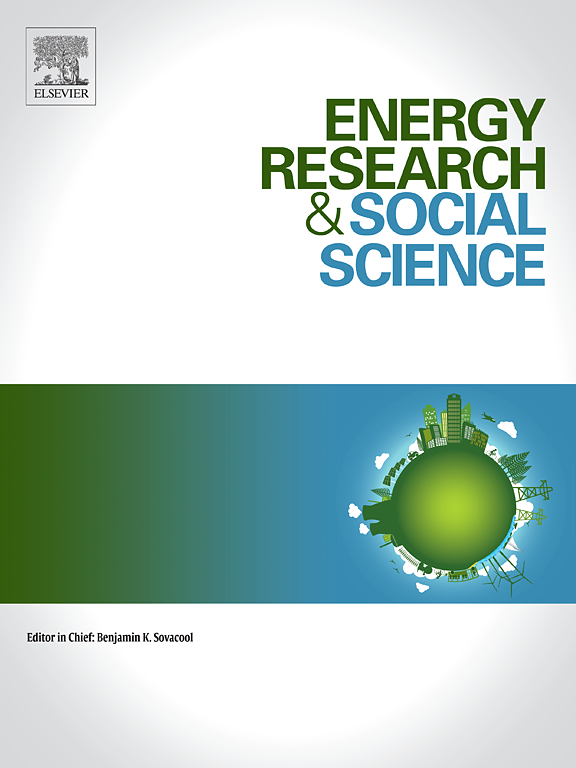Pathways for the Indian steel sector: Realizing low carbon industrial clusters through a place-based approach in eastern India
IF 6.9
2区 经济学
Q1 ENVIRONMENTAL STUDIES
引用次数: 0
Abstract
There is an increasing realization that current methods to produce materials which underpin modern society such as steel are unsustainable, a challenge particularly acute in India, a rapidly growing economy. However, amidst growing calls for ‘just transitions’ and the need to use a ‘place-based’ approach, conventional strategies for decarbonization that emphasize the adoption of frontier technologies by the steel majors may not be as applicable for certain industrial clusters in India such as those with many smaller firms. So how can industrial clusters in India embark upon sustainability pathways including decarbonization in a just, equitable way? To what extent do history, place-based identity, local socio-economic dynamics and public policy play a role and how?
Through document analysis and field research in two steel clusters in eastern India, the most prominent topic discussed by informants was around local socio-economic dynamics, followed by public policies supporting people and place-based identity, and then history. This reiterates the need for pathways to decarbonize clusters to emphasize the local. Furthermore, place-based themes were more pronounced in Giridih, suggesting that for certain clusters placed-based factors may play a stronger role in their potential to decarbonize. Specifically, we found that history influenced variation in workers' wellbeing by firms and awareness of rights and existence of social programs from government. Place attachment existed to both sacred places around the cluster and the cluster itself in Giridih), Place-based identity related to the cluster (steel, coal) and their surroundings (in Giridih to sacred places nearby) was also important. Local socio-economic dynamics helped explain which actors were deemed most legitimate: local elites in Giridih; central and state government in Durgapur such as the Steel Authority of India Limited (SAIL). Policies affecting people (social) such as workers' benefits varied depending on the cluster. These insights can help to develop appropriate decarbonization pathways within respective clusters; ones in which people and places are at the core.
印度钢铁行业的路径:通过印度东部地区为基础的方法实现低碳产业集群
人们越来越认识到,目前生产支撑现代社会的材料(如钢铁)的方法是不可持续的,这在经济快速增长的印度是一个特别严峻的挑战。然而,在越来越多的人呼吁“公正过渡”和需要使用“基于地方”的方法的情况下,强调钢铁巨头采用前沿技术的传统脱碳战略可能不适用于印度的某些产业集群,例如那些拥有许多小型企业的产业集群。那么,印度的产业集群如何以公正、公平的方式走上包括脱碳在内的可持续发展之路呢?历史、地域认同、当地社会经济动态和公共政策在多大程度上发挥了作用,如何发挥作用?通过对印度东部两个钢铁集群的文件分析和实地调查,调查对象讨论的最突出的主题是当地的社会经济动态,其次是支持人民和基于地方的身份的公共政策,然后是历史。这重申了对脱碳集群的途径的需求,以强调局部。此外,基于地点的主题在Giridih更为明显,这表明对于某些集群,基于地点的因素可能在其脱碳潜力中发挥更大的作用。具体来说,我们发现历史影响了企业和政府对权利和社会项目存在的认识对工人福利的影响。地点依恋存在于集群周围的圣地和集群本身(在Giridih),与集群(钢铁,煤炭)及其周围环境(在Giridih到附近的圣地)相关的基于地点的身份也很重要。当地的社会经济动态有助于解释哪些行为者被认为是最合法的:吉里迪赫的当地精英;中央和邦政府,如印度钢铁管理局有限公司(SAIL)。影响人(社会)的政策,如工人福利,因集群而异。这些见解可以帮助在各自的集群中开发适当的脱碳途径;其中,人和地方是核心。
本文章由计算机程序翻译,如有差异,请以英文原文为准。
求助全文
约1分钟内获得全文
求助全文
来源期刊

Energy Research & Social Science
ENVIRONMENTAL STUDIES-
CiteScore
14.00
自引率
16.40%
发文量
441
审稿时长
55 days
期刊介绍:
Energy Research & Social Science (ERSS) is a peer-reviewed international journal that publishes original research and review articles examining the relationship between energy systems and society. ERSS covers a range of topics revolving around the intersection of energy technologies, fuels, and resources on one side and social processes and influences - including communities of energy users, people affected by energy production, social institutions, customs, traditions, behaviors, and policies - on the other. Put another way, ERSS investigates the social system surrounding energy technology and hardware. ERSS is relevant for energy practitioners, researchers interested in the social aspects of energy production or use, and policymakers.
Energy Research & Social Science (ERSS) provides an interdisciplinary forum to discuss how social and technical issues related to energy production and consumption interact. Energy production, distribution, and consumption all have both technical and human components, and the latter involves the human causes and consequences of energy-related activities and processes as well as social structures that shape how people interact with energy systems. Energy analysis, therefore, needs to look beyond the dimensions of technology and economics to include these social and human elements.
 求助内容:
求助内容: 应助结果提醒方式:
应助结果提醒方式:


